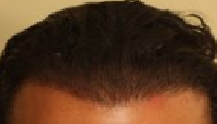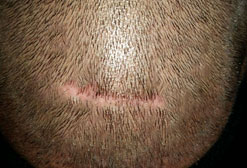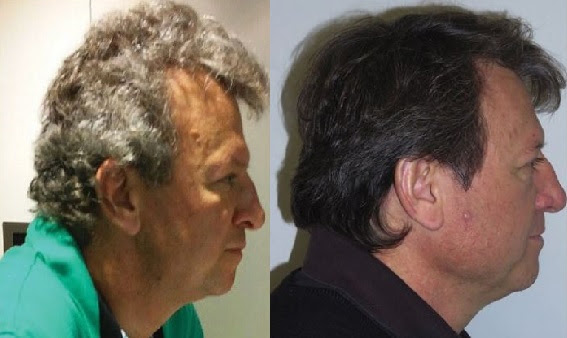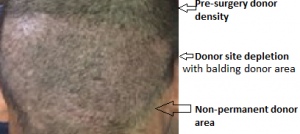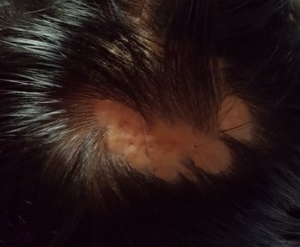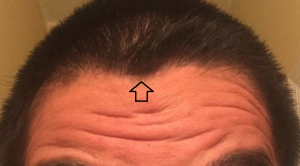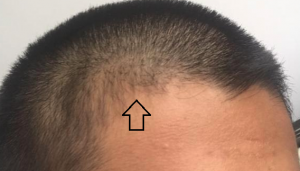There is no way to predict your results. If your doctor is good at what he did for you, you will get what you expected. Your expectations should have been set when the two of you met before the transplant was done. Now by the 8th month or sooner, you will see the results of your effort and the money you spent.
Does diffuse thinning only happen at the crown? Or can it happen all over the head (sides and back)? Also, if you are diffuse thinning or balding in general, can the sides and back become softer (individual hair becoming weaker and not as thick)? Or should the back and sides not be affected at all (at all as in should be as thick as when you were a kid/ teen)?
For men, thinning and balding occurs in patterns. For some men, crown thinning and balding is a pattern of hair loss, one that I personally had and transplanted it. If it is diffuse (all over the scalp) then there is a condition called Diffuse Unpatterned Alopecia (DUPA) something we originally defined in the medical literature in the 1990s which is a real problem for those who have it and these men are never candidates for hair transplantation. Diffuse hair thinning occurs in women but it does not occur in pattern and the causes for this are too many to list here.
Yes, you can add more grafts. What I would do is first determine if you liked the location of the hairline, if not I would put it where you wanted it to be. Then, I would certainly create a transition zone of single hair grafts (about 450 of them) so that the hairline looks like a no-hairline hairline. You should never be able to connect the dots on a hairline. Then I would fill it in where it is less dense. I would imagine it might take another 1500 or so grafts to accomplish this. Pictures show your hairline on the left and a repaired hairline on the right, fixed as I described.
My advice would be to not pick the crusts and return to your doctor. This patient should leave shampoo on the area for 15 minutes and then gently roll with the crusts using his finger once the crusts are water logged. This should be repeated twice a day. I am concerned that the central area may be necrosis. I would like this patient to go back to his doctor for an examination when the crusts come off. If it is necrosis, he will need wound care. This particular area is the area that is most susceptible to necrosis.
 Necrosis may be the cause of this unusual localized crusting.
Necrosis may be the cause of this unusual localized crusting.
This is an unusual scar. You can have it transplanted and then wait it out for a full eight months when you should see 80 per cent of the hairs growing. If you are not happy with it after 10 months, then maybe another transplant might be indicated, depending upon if you feel you have achieved the results you want. After the first procedure, with hair growing in it, you can perform Scalp MicroPigmentation behind it to address the color of the scar. This is something we do all of the time and it might make the scar disappear. I would reserve comment until I see what you would look like at 10 months.
I am curious as to the strength of a transplanted hair versus a natural hair. Lets say, a transplanted hair 1.5 years post the hair transplant surgery. If the transplanted hair was tugged on, would it be as strong as a normal hair, or is the transplanted hair always weaker then a native hair?
Tugging on a transplanted hair one year after the transplant is like tugging on a normal hair, no difference. They are both well rooted.
Hair distribution reflects judgments made between you and your doctor with your priorities in mind. There are many factors beyond balding patterns that dictate graft placement. These include:
(1) hair thickness,
(2) hair and scalp color,
(3) hair character (wavy or straight),
(4) your styling priorities (these can be put into the patterns of hair distribution created by the surgeon),
(5) available donor supply,
(6) your budget and
(7) your balding pattern.
Many of our patients can’t afford a very large session and have a limited budget. This is common enough so that I have learned to modify what I do to meet the needs of the patients. Of course, short term goals and long term goals may differ. The most important part of the transplant is to frame your face when you have frontal balding. For that reason, I focus on the frontal two inches and if you are willing or desire to part your hair on either the left or the right, I can extend the grafts back to the crown, weighting the grafts to your parted side. That may not be perfect, but it can produce a full looking head of hair in a person with medium hair thickness and wavy hair. A good relationship with your doctor is critical because this relationship should be a long term one.
As an example, I pulled up a Class 6 patient who still had a few fine hairs remaining in his crown. When I did the surgery, I used 2,500 grafts and weighted the graft placement to his parted side on the left. This example shows a reasonable result which can be thickened in a later surgery as his budget allows. He can add Scalp MicroPigmentation under these transplants which can avoid another surgery and get a much fuller look at any time. As it turns out, this 52 year old man was more than happy with this single hair transplant session and did not want another procedure.
I’m 26 years-old, 27 in October. Until around the end of last year, my hair loss hadn’t been very bad at all and was progressing much slower than the other men in my family. I was about a 3A/3V until I started noticing a bald patch appear on my crown about 4 months ago. Since then, the area around the patch has gotten noticeably thinner, and the front part of my hairline has also started to thin out. I started taking Minoxodil about a week ago as well as a few biotin tabs every day, and the shedding hasn’t been so bad. What is my future going to be like?
At 26, the advancement of your balding pattern is a bad omen for future balding. You should see a doctor experienced in this field. The drug Finasteride can slow, stop and sometimes reverse the balding but rarely will Minoxidil do this. The only real solution is hair transplant surgery so you might start, at the least, familiarizing yourself with this process. Look at this post to see results on patients who took Finasteride.
Cancer patients’ gray hair turns brown while taking new immune drugs
Associated Press
Published: July 23, 2017, 7:30 am
This undated combination of photos provided by the Journal of the American Medical Association in July 2017 shows a cancer patient with gray hair that unexpectedly turned dark while taking new immunotherapy drugs. Fourteen such cases were among 52 lung cancer patients being followed to see whether they developed bad side effects from the drugs – Keytruda, Opdivo and Tecentriq. (JAMA via AP)
CHICAGO (AP) — Cancer patients’ gray hair unexpectedly turned youthfully dark while taking novel drugs, and it has doctors scratching their heads.
Chemotherapy is notorious for making hair fall out, but the 14 patients involved were all being treated with new immunotherapy drugs that work differently and have different side effects. A Spanish study suggests that may include restoring hair pigment, at least in patients with lung cancer.
With the first patient, “we thought it could be an isolated case,” said Dr. Noelia Rivera, a dermatologist at Autonomous University of Barcelona.
But she said the research team found the same thing when they asked other patients for photos from before treatment.
The 14 cases were among 52 lung cancer patients being followed to see whether they developed bad side effects from the drugs — Keytruda, Opdivo and Tecentriq.
While most patients did not have a color change, the 14 cases suggest it’s not an isolated finding. In 13 patients, hair turned darkish brown or black. In one patient, it turned black in patches.
In another odd twist, the same drugs have been linked previously with hair losing color in patients with another cancer, melanoma.
All but one of the 14 patients in the Spanish study had at least stable disease and responded better to treatment than other patients, suggesting that hair darkening might be an indication that the drugs are working, the researchers said.
Rivera said they are continuing the study to search for an explanation and to see if the cases are just a fluke.
“It’s a fascinating report — one of those things that comes out of the blue,” said Dr. June Robinson, a Northwestern University research professor in dermatology. Robinson is also editor of the medical journal JAMA Dermatology, which published the study online this month.
She said the results deserve a deeper look but cautioned that it’s way too soon to suggest that they might lead to new treatments for gray hair.
Rivera noted that the study drugs have serious side effects that make them unsafe for healthy people. But if it’s confirmed that they do change hair color, a different drug could be developed to treat gray hair, she said.
The pharmaceutical industry has previously capitalized on unexpected drug side effects; examples include the male pattern baldness drug Propecia, the eyelash growing drug Latisse, and Botox anti-wrinkle injections. Active ingredients in these drugs were initially approved to treat enlarged prostates, eye pressure problems, and eye muscle spasms.
THIS IS A VERY IMPORTANT READ FOR ANYONE WANTING TO HAVE FUE; I wrote this article in the past issue of Hair Transplant Forum (Volume #27, #2, May/June 2017) which I believe defines a very important guideline for determining how many FUE grafts are safe. This is illustrated well in the previous post below. We are seeing doctors from around the world performing FUE grafts in the thousands without understanding the limits of this surgery. The goal for many patients, is to get all of your hair back in a single hair transplant FUE session. But that goal is not reasonable for many patients with FUE especially when the donor density is low like most Indians, Asians, South Americans, and people from the Middle East. Europeans or Russians often have higher donor densities. The article poses a formula the the doctor can use to actually calculate the safe number of grafts for any particular individual. You have a responsibility to research what your doctors are going to do for you, because if you don’t and if your doctor removes too many FUE grafts from your donor area, you will become bald in the donor area, a bad exchange from balding in the front or the top of your head. You must realize what the risks are and if the safe limits of FUE are exceeded. Many patients who end up with a depleted donor area like the previous post, have little choice on how they are to manage their new balding problem as they may become bald in the back of their head. This article addresses this problem and suggests ways doctors and patients can guarantee that the safe limits for FUE are not exceeded.
full-forum-fue-article CLICK TO ENLARGE
When your original donor density is lower than average, 3000 grafts can be too many grafts harvested through FUE and this causes donor site depletion such that the donor area has a problem with a see-through look. The doctor should have measured your donor density before pushing large numbers of FUE grafts. For some people with very low donor densities, 2000 grafts could cause donor site depletion. It seems that in this situation, the surgeon could not get the entire 3000 grafts from the permanent zone, so the surgeon moved outside the permanent zone into the neck (which is not permanent hair) and possibly also above the permanent zone into another area that may sooner or later may bald. The only treatment for this is scalp micropigmentation, something we do all of the time. https://scalpmicropigmentation.com/ This technique can make your donor area LOOK normal but it will not put more hair there
Tattoos: Does ink travel through your body?
Published Friday 14 July 2017
By Yella Hewings-Martin, PhD
The body stores tattoo ink in cells and between collagen bundles in the dermis. But some pigment particles go on a longer journey. What happens when tattoo ink is injected into your skin? Most of it remains firmly lodged there, but some pigments travel to lymph nodes or even destinations in your body that are farther afield. All the while, you are left sporting a new tattoo. internal organs with a unique color display.
To read the rest of this article see here
Dr. Robert Bernstein has put together a terrific group of before and after photos from people who used medications such as finasteride, without surgery. Look at this link: https://www.bernsteinmedical.com/medical-treatment/patient-photos/
These are great pictures. You have not developed a mature hairline yet as you have maintained much of your juvenile hairline, but there is a suggestion in the corners that you may be moving your hairline up in the direction of a mature hairline so this may not be balding as you may be transitioning into a more mature hairline. A hand microscope will help to see if you have miniaturization in these corner areas but wait this out as time is the best way to know. I rarely see men in this transition stage, so thanks for sharing these photos with me. Contact me in a year and repeat the photos, then we might know the answer to what is happening to you. The arrows show both the juvenile center of your hairline and the changing corners.


